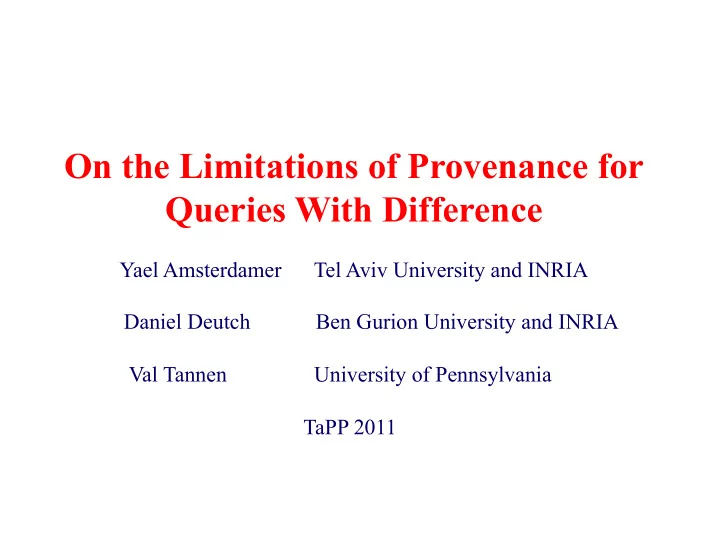

On the Limitations of Provenance for Queries With Difference Yael Amsterdamer Tel Aviv University and INRIA Daniel Deutch Ben Gurion University and INRIA Val Tannen University of Pennsylvania TaPP 2011
Starting Point: Provenance Semirings • Provenance semirings [(K,+,·,0,1)] were originally defined for the positive relational algebra • Two important features of semirings – Algebraic uniformity – A correspondence between the semiring axioms and query (bag) equivalence identities: the semiring axioms are dictated by the identities!
Correspondence of identities Query Identities Algebraic Identities R ∪ (S ∪ T) = (R ∪ S) ∪ T a+(b+c) = 1 (a+b)+c 2 R ∪φ = R a+0 = a R ∪ S = S ∪ R a+b = b+a 3 R ( S T) = a·(b·c) = 4 (R S) T (a·b)·c 5 R 1 = R a·1 = a 6 R S = S R a·b = b·a 7 R (S ∪ T) = a·(b+c) = (R S) ∪ (R T) a·b+a·c 8 R φ = φ a·0 = 0 Semiring axioms!
Security = ( S , MIN , MAX , 0,1) S = {1,C,S,T,0} Emps GoodEmps 1 < C < S < T < 0 Dep. Emp Prov. Emp Prov. Eng. Alice S Alice C Eng. Bob T Bob S Sales Carol S Carol T π Dep (Emps GoodEmps) Dep. Prov. Eng. S · C+T · S = S + T = S Sales S · T = T
Suggested semantics for difference • m-semirings [Geerts Poggi '10] a − b is the smallest c such that a ≤ b+c (works for naturally ordered cases: a ≤ b ⇔ ∃ c a + c = b is an order relation) • By encoding as a nested aggregate query [Amsterdamer D. Tannen PODS '11] a-b=a if b=0, otherwise 0 (for positive semirings) – Also suggested for SPARQL [Theoharis, Fundulaki, Karvounarakis, Christophides '10] • Z-semantics [Green Ives Tannen '09]
Abstracting away • Can we extend the framework to support difference? • Work with a structure (K,+,·,0,1,-) • We still want (K,+,·,0,1) to be a semiring • How do we define the additional operator? • Let us try to throw in more axioms – A subset of those that hold for bag and set semantics
Additional Identities Query Identities Algebraic Identities 9 R – R = φ a – a = 0 10 φ – R = φ 0 – a = 0 R ∪ (S – R) = a+(b – a) = 11 S ∪ (R – S) b+(a – b) R – (S ∪ T) = a – (b+c) = 12 (R – S) – T (a – b) – c R (S – T) = a·(b – c) = 13 (R S) – (R T) (a·b) – (a·c)
Impossibility of satisfying the axioms • Distributive lattices are particular semirings with an order relation such that – a+b is the least upper bound of a and b – a·b is the greatest lower bound of a and b – The security semiring, Three Value Logic are concrete examples • Theorem If (K,+, ·, 0, 1, − ) is an (extension of a) distributive lattice such that axioms 1-12 hold, and there exists in K two distinct elements a, b s.t. a > b and (a − b) · b = 0 then axiom 13 fails in K.
Key observation • Let (K,+,0) be a naturally ordered commutative monoid – Commutative monoid means axioms 1-3 hold – Naturally ordered means a ≤ b ⇔ ∃ c a + c = b is an order relation Theorem [Bosbach '65]: Axioms 9-12 hold if and only if a − b is the smallest c such that a ≤ b+c
Key Observation (cont.) • For the security semiring, with a = S, b = T we get a − b = S and (a − b) · b = T = 0 And indeed: (S − T) · T = S· T = T but S·T – T · T = T–T = 0
( S , MIN , MAX , 0,1) S = {1,C,S,T,0} 1 < C < S < T < 0 GoodEmps Emps FiredEmps Emp Prov. Emp Prov. Emp Prov. Alice S Alice C Alice C Bob T Bob S Bob S Carol S Carol T Carol T GoodEmps (Emps– FiredEmps) Emps GoodEmps – FiredEmps GoodEmps Emp Prov. Emp Prov. .. .. ... … Carol T Carol 0
Where do solutions fail? Query Identities Algebraic Identities Fail for: R – R = φ a – a = 0 φ – R = φ 0 – a = 0 Z-Semantics R ∪ (S – R) = a+(b – a) = Agg, SPARQL S ∪ (R – S) b+(a – b) R – (S ∪ T) = a – (b+c) = (R – S) – T (a – b) – c R (S – T) = a·(b – c) = m-semirings (R S) – (R T) (a·b) – (a·c)
So what can we do? • Work with a restricted class of semirings – We show in the paper another security semiring that is not a lattice; we use sets of security levels – Can we characterize the class for which bag equivalences hold? • Give up on some of the equivalence axioms • Give up on a uniform definition of difference
Recommend
More recommend